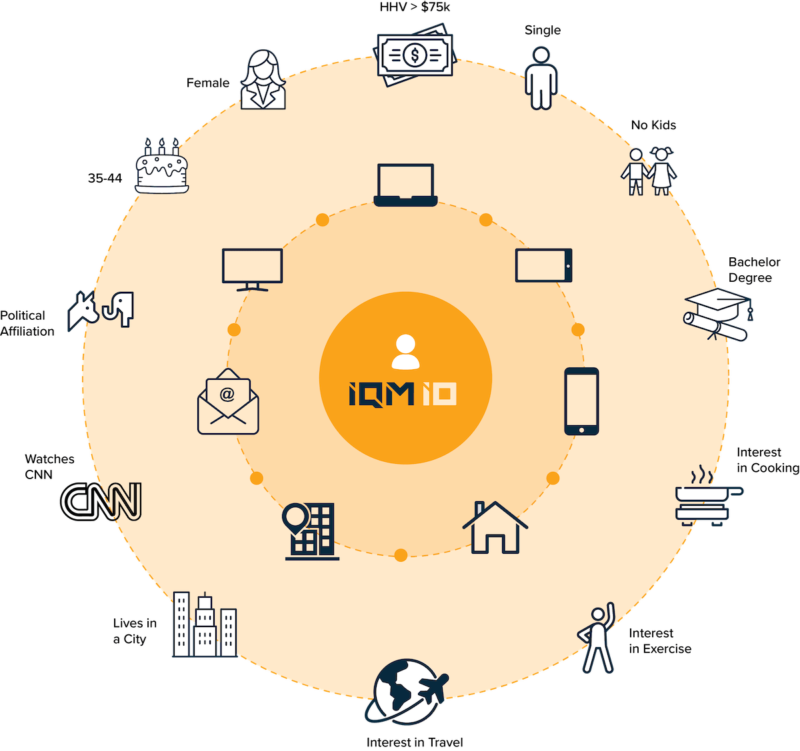
Identity Resolution: A Guide to IQM’s Identity Graph
July 9, 2024 | 6 min read
IQM’s Identity Graph
The average American has 22 connected devices*, providing both opportunities and challenges for advertisers. The key to effectively reaching your audience throughout their journey is the ability to recognize voters across channels and devices and unify identifiers to a single profile.
What is an Identity Graph?
An identity graph links disparate identifiers, both online and offline, to allow advertisers to recognize an individual consumer across all of their devices, and create a unified and accurate profile of each consumer. These profiles help advertisers understand and engage with their target audience.
The Importance of Identity Graphs
Identity graphs are important because today’s consumer journeys are more fragmented than ever. For example, a consumer may begin looking at a product or researching a topic on their mobile device, continue their research on another device from a different location, like on a laptop at work, and finally, purchase a product, book a hotel room, or schedule an appointment from another device, like a tablet. In order to message this consumer, an advertiser must be able to identify them across these touchpoints and reach them with effective messaging.
Additionally, third party cookie deprecation makes a varied and scaled identity graph important for the future of digital advertising. Marketers can no longer rely only on 3rd party cookies to identify, track and measure their campaigns.
How IQM’s Identity Graph Works

IQM collects billions of data signals from various sources (see below) and maps these signals from multiple consumer identities into pseudonymized identifiers.
Our machine learning model identifies pseudonymized identifiers and leverages both probabilistic and deterministic methodologies to make connections between them, thereby concluding they are associated with one individual.
That individual is given an IQM ID, a person-level identifier that can now be targeted via programmatic campaigns.
IDs:
- Cookies
- MAID
- CTV IDs
- Hashed emails
- IP addresses
- Hashed phone numbers
- Hashed household addresses
Data Signals:
- Wifi address
- Time stamp
- Geolocation
- Browser attributes
- Device attributes
- User agent
- Contextual data
- Browse and click stream data
Data Partners/Sources:
- Census
- From Open RTB data
- Geo-location data provider
- IP data providers
- From first party publishers (web and app)
- From DMP partners
- From cross-device data partners
- See all IQM’s Partnerships
Additionally, we can conclude that multiple individuals come from the same household. To do this, we identify multiple IQM IDs that are consistently associated with the same signals, such as IP address, and deduce that they are likely from the same household. These IQM IDs are grouped together and given one IQM HH ID (household-level identifier).
How Often is the IQM ID Graph Refreshed?
The graph is updated daily for minor changes based on signals observed in the previous 24 hours. It also undergoes a major refresh monthly, to ensure the IP addresses, devices and cookies observed are still active and reachable.
Is IQM’s identity graph privacy compliant?
Yes. IQM does not track any device or cookie with “do not track” setting enabled and follows CCPA and GDPR guidelines.
Use Cases Enabled by the Identity Graph
Campaign Planning – ID graph enables estimation of audience size and reach, especially helpful when applying demographic or geographic filters to your audience
Targeting:
- Matched Audiences – customers who have first party data they would like to target in their digital campaigns can do so by creating a matched audience in the IQM platform. Matched audiences are enabled by IQM’s ID graph.
- Cross-Device Targeting – Extend messaging to your audience across all the devices they use
Insights & Reporting:
- Audience Insights – Receive an audience insights report on matched audiences containing at least 10k uniques. These reports provide key demographic insights, like ethnicity, household income, gender, age, etc, and also compares your audience to the US national average for each dimension.
- Reach & Frequency Measurement – understand how many unique individuals were reached and how often they were exposed to your message
FAQ
What is the IQM ID?
IQM ID is a pseudonymized universal Identifier that is tied to devices and cookies in IQM’s Identity Graph. Each IQM_ID can be thought of as related to an individual person and having demographic, psychographic segments attributed to it. Both links to devices/cookies as well as segment attribution may vary for IQM_ID time to time as more signals are received and learned over a period of time.
What is the IQM HH ID?
IQM HH ID is a pseudonymized collection of IQM IDs which are part of the same household within the IQM Identity Graph. IQM HH ID has segment attribution at household level. E.g. household income, family size and mix etc.
What signals does IQM collect to create this identity graph?
IDs
● Cookies
● Device IDs
● Hashed emails
● IP addresses
● Hashed Phone Numbers
● Hashed household addresses
● Internal Ids – IQM ID & IQM HH ID
Signals
● Wifi address
● Time stamp
● Geolocation
● Browser attributes
● Device attributes
● User agent
● Contextual data
● Browse and click stream data
Where do the signals and IDs that IQM collects come from?
● Census
● From Open RTB data
● Geo-location data provider
● IP data providers
● From first party publishers (web and app)
● From DMP Partners
What is the scale of IQM’s ID Graph?
● 250M+ US individuals (about 75% of US population)
● 102M+ US Households (about 78% of US households)
Does the ID Graph only cover the US?
Currently, it only covers the US.
What does pseudonymized mean?
Pseudonymization is a process used in data protection that replaces personally identifiable information (PII) with a pseudonym. The data has been de-identified, but can be reversed and re-identified. This is different from anonymized data in that it has been changed so that re-identification is impossible.
What is the difference between deterministic and probabilistic methodologies?
Deterministic methodologies rely on strict, exact matching criteria to link identities. For example, if two records have the same email address, they are considered the same identity. Deterministic is ideal for accuracy, but scale is often very limited.
Probabilistic methodologies use likelihood based on similarities and patterns in observed signals to establish connections between identifiers. While probabilistic has the potential to be less accurate, it provides much greater scale for the identity graph.
IQM’s graph employs a combination of both methodologies to strike a balance between accuracy and scale.









